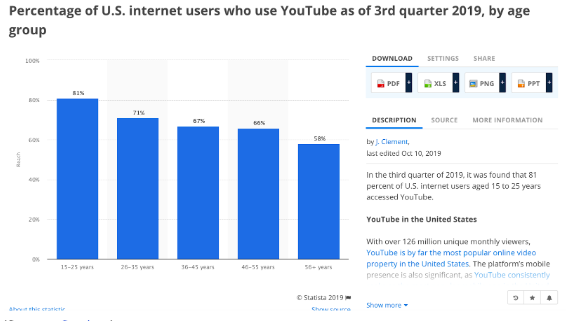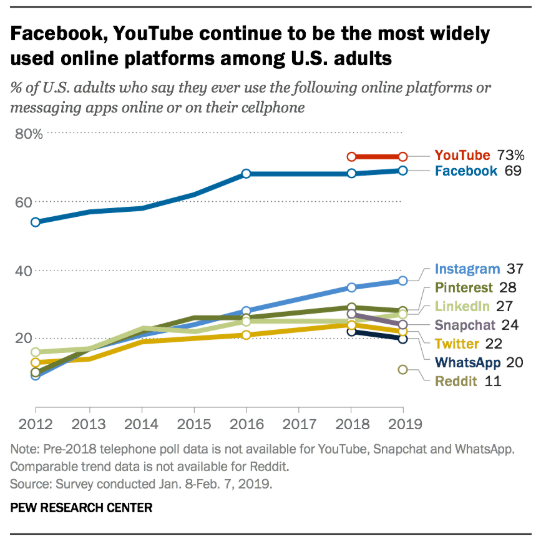This year’s YouTube stats show that—spoiler alert—YouTube is still bigger than all the other social media platforms. (And every other website, too, except for Google.)
Whether you’re a first-time creator looking to grow your YouTube subscriber count, or an experienced video marketer looking to increase your brand’s video views on YouTube, the first step towards mastering this platform is getting a handle on the numbers. Not to mention staying up to date with them.
Below, we’ve got the year’s new numbers: who’s using Youtube? How are they using it? And what does that mean for business?
Table of contents
YouTube user statistics
YouTube usage statistics
YouTube for business statistics
YouTube advertising statistics
YouTube user statistics
1. YouTube has 2 billion logged-in monthly users
YouTube’s user base is still growing every year. Their user population was only 1.8 billion in May 2018.
2. 73% of adults in the U.S. use YouTube
That’s more than Facebook (69% of American adults). And it’s almost twice as much as the next runner-up, Instagram (37%).
According to Pew Research, YouTube is the most popular online platform in America.
Sidebar: We’re guessing Pew doesn’t classify YouTube as a ‘social’ platform because it’s a bit of a chimera: is it video platform or a search engine or a social network? Most people on YouTube aren’t actively creating videos, though they might be participating in the comments or subscribing to channels (or just revisiting their favorite Vine videos.) For more guidance on how this unique beast functions, take a look at our complete guide to YouTube marketing.
3. 81% of 15–25 year-olds in the U.S. use YouTube
YouTube consistently gets more popular the younger the age group you look at.
YouTube itself likes to quote a stat from a study it commissioned a few years ago that says on mobile alone it reaches more 18–34 year-olds than any TV network.

4. Almost 15% of YouTube’s site traffic comes from the U.S.
According to Alexa’s estimates, YouTube viewers are most likely to be in the U.S. Next runners up: 8.1% of YouTube viewers are in India; and 4.6% are in Japan.

5. 93% of video watchers in India are watching YouTube
YouTube is ubiquitous in its second-biggest market, India, with consistent double-digit growth every year.
Also, compare that to Netflix’s market share in India, which is a very measly 3% of people who watch video online.

6. Only 33% of popular YouTube videos are in English
When Pew Research looked at activity on popular channels (i.e., ones with more than 250,000 subscribers) in the first week of 2019, they found that only 33% of the videos those channels uploaded were in English, and only 17% were completely in English.
YouTube works in 80 different languages and 91 different countries, so this is not really a surprise.
YouTube usage statistics
7. People upload 500 hours of video every minute
Competition is fierce out there for brands and creators.
Also: our appetite for video content is still increasing—or at least our appetite for creating it. This number has increased 40% in the five years between 2014 and 2019.
8. Each visitor spends 11m 24s per day on YouTube, on average
This is according to Alexa, as of late 2019. And that number is up from the year prior (2018), when it was 8 minutes and 41 seconds.
9. 70% of what people watch on YouTube is determined by its recommendation algorithm
According to YouTube execs, anyway. Independent research supports this, with 81% of U.S. adults saying they occasionally or regularly watch videos recommended by the algorithm.

10. Each visit to YouTube involves 6.5 pageviews, on average
Yes, people let the algorithm decide what they’ll watch. But also, more pageviews suggest a more active audience, as people click around to explore new channels and videos.
11. 10% of the most popular YouTube videos draw 79% of views
Pew Research looked at almost 44,000 channels with 250,000 subscribers or more, and concluded that a small share of videos—and creators—are disproportionately popular.
And not only do popular channel’s most popular videos grab most of the attention, when it comes to the quantity of YouTube videos, only 10% of YouTube channels make 70% of the most popular videos.

12. Over 70% of YouTube views are on mobile
This number has been steady since late 2018. Either it hasn’t changed, or the good folks at YouTube have decided not to update us. (That said, in 2019 YouTube was the #1 iOS app again.)
We’re keeping this here because it’s an important reminder to keep mobile top-of-mind when creating video.
13. YouTube views on connected TV screens have increased 39%
Yes, keep mobile top of mind for your video creation, but don’t forget big screens.
YouTube says 250 million hours of watch time per day are happening on TV screens. (Elsewhere, YouTube also says people watch about one billion hours of video on the platform every day.)
YouTube for business statistics
14. When choosing what to watch, whether a video relates to a viewer’s interests is 3x more important to people than whether it has a famous actor
This stat—straight from YouTube itself—implies that brands should spend more time getting to know their audience and what they care about, and spend less money trying to dazzle them with lowest-common-denominator tactics (like celebrity guest stars).
15. Likewise, relevance to personal interests is 1.6x more important to viewers than production value
As well, YouTube says that 60% of people who’ve watched YouTube in the past day say that they watched videos that were related to their personal interests.
The most valuable video content isn’t necessarily the most slick and expensive. Brands who have pinpointed their audience’s needs will have a much easier time promoting their YouTube channel.
16. Watch time for videos on “which product to buy” doubled between 2017 and 2018
Brands on YouTube can take advantage of the fact that people are turning to YouTube videos more and more as they research and decide which product to buy.
Keep in mind that 80% of people who said that they watched a YouTube video related to a product they want to buy said that they did so at the beginning of their buying process.
Potential customers who are connecting with your brand on YouTube don’t necessarily just want to be advertised at. They are looking for genuinely helpful videos that inform and inspire. (And maybe include a killer CTA).
17. 70% more YouTube users are engaging with creators and channels
Between 2017 and 2018, YouTube users increased their daily engagement with creators and videos.
In other words, viewing habits are changing on YouTube. Casual viewers may be more likely to become loyal fans—if your brand can connect with them.
YouTube ad statistics
18. People are watching 70% less harmful/misinformative/borderline video content on YouTube
This is the platform’s own number, as YouTube looks to measure whether their algorithm changes in January 2019 actually helped with their brand safety problem.
This stat is meant to reassure advertisers and brands who don’t want their commercials running alongside, say, fake cancer cures. It’s in YouTube’s best interests to take this problem seriously.
YouTube also reports that this 70% reduction means that less than 1% of watch time in the U.S. is now spent on borderline content. So if your brand is running YouTube ads, you can rest assured that your ads are more likely to run alongside pleasant meditation videos.
19. In the U.S. alone, YouTube will make 5.5 billion dollars in advertising revenue in 2020
That’s almost double what YouTube made off ads in 2016. Statista’s researchers credit an overall increase in online video consumption in the U.S.

20. The number of channels that earn $10,000 USD per year or more on YouTube grew by 50%, year over year
And in the same period, the number of channels earning $100,000 USD per year or more grew by 40%.
Of course, this kind of income isn’t just from ad revenue, it might include multiple forms of YouTube monetization. Regardless, it’s tough to say if this is good news for all content creators on YouTube, or just the really successful ones.
(Nota bene: We feel compelled to point out that YouTube says this growth happened year over year, but does not mention which years.)
21. YouTube’s Google Preferred ads lift ad recall by 112%
YouTube’s Google Preferred ads are ads that run on YouTube’s top 5% most popular channels, so we would expect that these numbers would be impressive.
Apparently, they also increase purchase intent by 53%. Something to consider if you have ad budget to spend.
On the other hand, if you’re new to advertising on YouTube, you’re going to want to check out our guide to YouTube advertising.
22. YouTube is the second most-preferred platform for watching video on TV screens among 18 to 34 year olds, after Netflix
In other words, YouTube is the most-preferred platform that has ads for watching video on TV screens.
What’s most interesting to advertisers here is that for millennials who are watching TV screens, YouTube beats traditional TV—both basic cable and broadcast networks.
23. Men speak 2x as much as women in YouTube ads, and receive 56% of overall screen time
The Geena Davis Institute on Gender in Media partnered with Google to analyze 2.7 million YouTube ads (including 550 billion views) uploaded between 2015 and 2019.
The study concluded that while advertisers tend to create ads that feature men more often, people watched them less. In fact, 56% of video views were from people watching gender-balanced or women-led ads.
Grow your YouTube audience faster with Hootsuite. From one dashboard, you can manage and schedule YouTube videos alongside content from all your other social channels. Try it free today.
Get Started
